Portrait
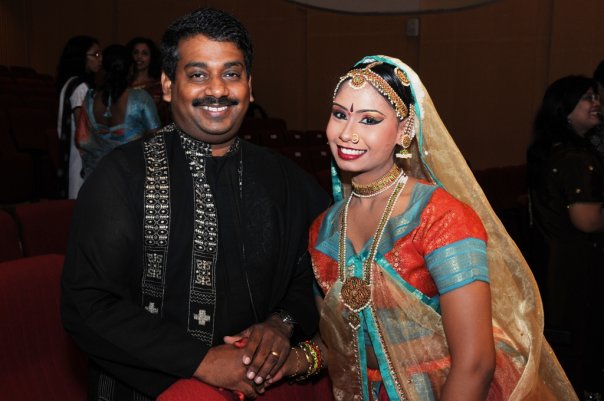
Multi-Tasking with a Magic of her Own! Donning various hats as the Admin Manager of Apsaras Arts, Dancer, Project Manager, Tour Manager, make-up artiste and also as a wardrobe assistant, Sankari Elavalahan gives us an account of her early days of association with Apsaras Arts and her return to work with her Alma Mater Were you born and raised in Singapore? Do you remember how and when dance happened in your life? Yes, I am a second generation Singaporean. My paternal grandparents are from Thanjavur and maternal grandparents are from Karaikal. I was exposed to dance at a very young age. I spent most of my afternoons and weekends at my maternal grandmother’s home as my mother was working full-time and was a part-time bridal makeup artist over weekends. My Chitti, Barathi, who is more of an older sister to me, was learning Bharatanatyam and performing quite frequently at festivals and community centres. I would sit by my mother’s side and watch her dress Chitti for her performance. I was completely awestruck by the costumes, accessories, make-up and the attention she was getting. Once fully dressed, my mother would ask her to pose for photos and I was so fascinated by her flexibility and elegance. I remember having major meltdowns whenever she was leaving and pleaded to them to take me for her shows. My cousin, Shanmugapriya who was also learning Bharatanatyam and touring internationally as part of Neila (Sathyalingam) Maami’s Little Angels, Singapore’s first multi-ethnic children’s dance troupe, was also a huge inspiration for a five-year-old me. I pestered my mother to send me for dance classes and within a few months of attending classes, I had volunteered to perform solo at my pre-school graduation for the then Deputy Prime Minister, current Prime Minister Lee Hsieng Loong. All my classmates cheered for me and it was truly a diva moment for me. You were initiated into dance by none other than Neila Sathyalingam mami. What were your early experiences with her and how did she inculcate the love of dance in you? I started learning formally at the age of five with Vani Akka aka Kamalavani Anbarasu who was a senior student of Neila Maami at the Kallang Community Centre. Vani Akka was an excellent dancer herself and as a teacher she was approachable, patient and motivating. She made learning dance enjoyable while focusing on achieving the desired outcomes with us. My early encounters with Neila Maami was when she would take our classes on days when Vani Akka had to be away. I was so frightened by the tall, big-eyed, Neila Maami with a strong British accent, and her thattu kazhi, which she used to point at students and correct our postures. As I entered teenage, like all teenagers, I started having a love-hate relationship with Bharatanatyam and was not attending classes regularly, which I regret deeply till this date. However, Neila Maami noticed that I had a natural flair for semi-classical, folk and filmy dance items and initiated me to join The People’s Association (PA) Indian Dance Troupe where she was the choreographer, just to keep me dancing. I was a Star amongst The Galaxy as the theme for our float was The Milky Way as part of the 1999 Chingay Parade. Chingay Parades are huge fun with over 30 cultural contingents all over Singapore and Asia gathering annually for a lively display of Singapore’s multicultural heritage. Instead of discouraging and correcting my Bharatanatyam style, Neila Maami recognised my energy and passion in dance and showed me a path that would continue to inspire my journey. Maami was a visionary and all she wanted was for her students to keep dancing and for the flame to stay alive and burning. Talk to us a bit about your performance career in dance. Are you also trained in nattuvangam and music? If yes, tell us a bit about it. I started at the age of 15, as the youngest troupe member in 2000 at the PA Indian Dance Group and was given training to various dance forms such as Chinese Dance, Malay Dance, Modern Dance, Flamenco, Bhangra, Thevarattam, Mayilattam and Kalaripayattu. We even had a trainer from the Chennai Raack Academy of Dance to train us in Bollywood HipHop. Although I was very much active at PA with a two days a week training routine, I continued my Bharatanatyam practice with Neila Maami at the Telok Ayer Performing Arts Centre (TAPAC) over weekends and performed regularly at the Navarathri festivals and community events. I was also heavily involved in local TV dance competitions representing my tertiary institution in which we had emerged as runner-up and champions in my final year. One evening after the PA rehearsal, in the car with Maami, as usual Maami was asking about our thoughts regarding a recent Arangetram we had attended. I innocently shared with her that if I was ready to do an Arangetram and that I would like to do an all film song margam instead of the usual so that it would be more relatable and be better enjoyed by my family and the audience that would attend. She listened quietly and said. “Mama will never agree to this!”. Sathyalingam Mama that way was quite a traditionalist. In February 2008, during the Sivagami, post-show appreciation lunch and Maami’s birthday celebration, I went to Mama and Maami to get their blessings, when she turned around to Mama and said, “Listen, please bless this girl as she would like to get an all film song Arangetram.” I was pleasantly surprised and elated. Firstly, it was news that I was ready for my Arangetram and secondly, the fact that she was actually proposing the all film song Arangetram idea to Mama. Soon after that event, my Arangetram preparations began. My mother and I flew to Chennai and we were introduced to Radhika Shurajit M’am to choreograph two items, Om Namashivayaa from the famous Tamil film, Salangai Oli as my Padam and Thillana from the Tamil
In Sights
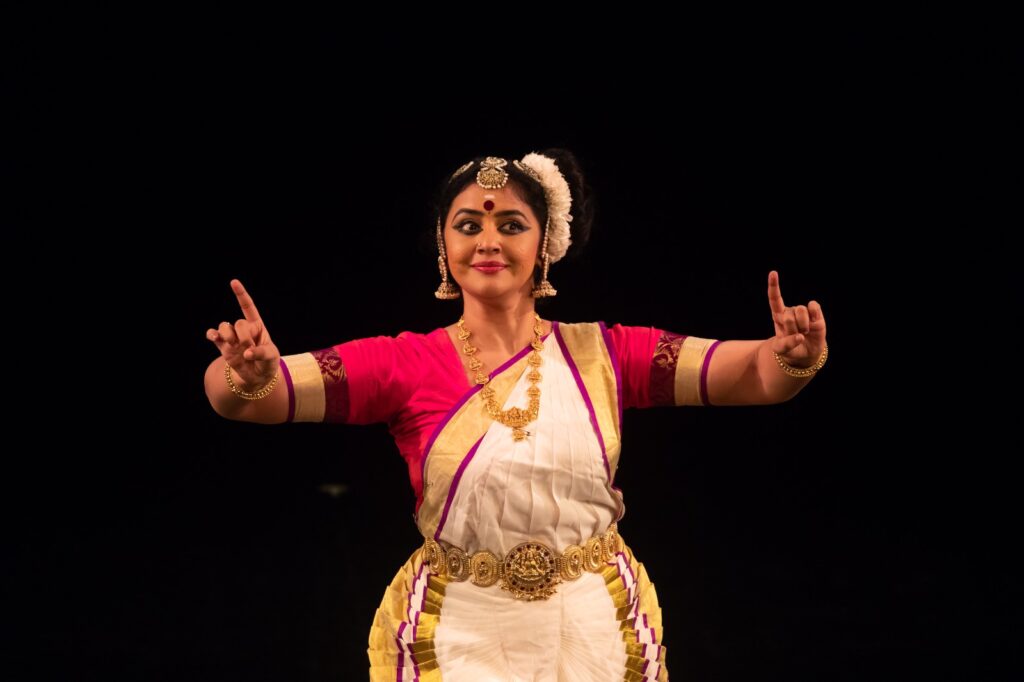
Looking back at IPAC The Indian Performing Arts Convention (IPAC) 2023 forayed into its 12th edition this year and was held between June 17 and June 25, this year. IPAC featured week-long Masterclasses, lecture demonstrations and performances by distinguished faculty from India. Read on for a summary of what it entailed… The Convention began with an invocation by the students of Mohanapriyan Thavarajah, followed by a sharing by Artistic Director of Apsaras Arts, Aravith Kumarasamy, wherein he introduced the Convention and what’s in store. With careful thought and planning, IPAC featured Masterclaasses for dance and music that were curated for practitioners and teachers across different levels in the arts. The lecture demonstrations too straddled an array of subjects and were presented with clarity and conviction by the presenters. Bharatanatyam exponents, Rama Vaidyanathan and Bragha Bessell conducted Masterclasses for Intermediate and Advanced levels of dance practitioners while Priyadarsini Govind and Ramaa Bharadvaj held sessions for aspiring teachers on methods and techniques of teaching and choreographing for dance. The inaugural day workshop was conducted by Bharatanatyam dancer-choreographer-teacher, Shankar Kandasamy who worked around the theme of Finding Poetry in Nrtta. There was also a special workshop by Koodiyattam exponent, Kapila Venu on how to prepare the body for Koodiyattam. This was a truly insightful session and also allowed participants a good understanding of the basics of Kootiyattam. VR Devika, Ananda Shankar Jayant and Methil Devika also presented lecture demonstrations as part of IPAC. IPAC also had space dedicated for music and two Masterclasses – one on vocals and another on violin – were conducted by Dr S Sowmya and Embar Kannan respectively. For a complete coverage on IPAC Masterclasses and lecture demonstrations, read this article featured in Sruti. The highlight of IPAC, as always, is the showcase of performances by artistes, every evening and this year too it was grand and meticulously planned by the Artistic Director of Apsaras Arts, Aravinth Kumarasamy. Bharatanatyam dancer, writer, educator and storyteller Ramaa Bharadvaj reviewed three performances that stood out in this series of evening showcases… Here are some key highlights from her observations… Koodiyattam exponent Kapila Venu’s Mahishasuravadham premiered on Day one, June 23, 2023 of IPAC. In Ramaa’s words, the Esplanade- Theatre on the Bay, turned silent as they watched Kapila breathe life into the character of Devi and transform into a Devi herself. It was a moving performance and the audience gave the performance a standing ovation. The second best performance according to Ramaa Bharadvaj was Mohanapriyan Thavarajah’s Skanda Rasam, a solo work on Lord Muruga. In Ramaa’s words, the true flavour of Skanda rasam was evident right from the decorations of the theatre to the backdrop of the stage, in the dance, the costume, aesthetics and the music. In total, everyone was soaked in the fervour of Muruga. Aravinth Kumarasamy’s story narration in between the pieces added effect and edge to the already splendid performance. Anaavaran, Mohiniattam exponent, Methil Devika’s performance also stole the hearts of the audience. Her performance comprised a six-part presentation of carefully chosen pieces depicting a variety of emotions. Devika’s brilliance as a dancer, choreographer, performer and musician came across very clearly in her performance, said Ramaa Bharadvaj. IPAC at the Esplanade – Day 1 (Mahishasuravadham – The slaying of Mahishasura – Kapila Venu)By Ramaa Bharadvaj One of the highlights of the IPAC experience consisted of the professional showcase performances presented by Apsaras Arts in collaboration with the Esplanade Theater. Curated carefully by Aravinth Kumarasamy, this year, there were three events that acted like three crowning ‘kalasams’ to the IPAC temple tower. Here I share my experience of each evening in three parts. PART 1 of 3: June 23, 2023: “MAHISHASURAVADHAM”:The first day of IPAC’s Showcase performance at Esplanade began with the booming sounds of “mizhavu’ and ‘edakka’ drums bringing not only ‘God’s own Country’ to Singapore, but the goddess Herself. Petite in form but massive in energy was Kapila Venu as she presented the slaying of Mahisha in Kerala’s Koodiyattam style. The daughter of the legendary exponent G. Venu, Kapila is the ideal torchbearer of her father’s legacy. She depicted Mahishasura’s fierce encounter with Devi through deliberately controlled and highly stylized gestures, radiating a mesmerizing intensity. Finally, as Devi drinks over and over from the wine goblet and rises in intoxicated ferocity to behead the ‘asura’, the audience watched Kapila’s fearsome transformation in reverential silence.The Natyashastra speaks of the success or ‘siddhi’ of a performance as being of multiple kinds. Of these, the ‘dhaivi siddhi’ or divinely blessed success is said to elicit stunned silence from spectators. Kapila’s performance had that effect on the audience, but only for a brief moment; for soon the entire theater jumped to their feet to acknowledge her marvelous mastery, with a sustained ovation. As for me personally the effect continued long after I walked out of the theater and joined my colleagues at a restaurant for dinner. How does one walk up to a goddess and tell her she was spectacular? Finally, when I did tell her how I felt she laughed sweetly, and we became friends. That’s right! I befriended a goddess!I’ll see you tomorrow with my views on the second performance, when a warrior god manifested onto the Esplanade theater!– Ramaa Bharadvaj (July 11, 2023) IPAC at the Esplanade – Day 2 (Skanda Rasam – Mohanapriyan Thavarajah )By Ramaa BharadvajOne of the highlights of the IPAC experience consisted of the professional showcase performances presented by Apsaras Arts in collaboration with the Esplanade Theater. Curated carefully by Aravinth Kumarasamy, this year, there were three events that acted like three crowning ‘kalasams’ to the IPAC temple tower.In this writing, I share my experience of each evening in three parts.PART 2 of 3: June 24, 2023: “SKANDA RASAM”: When Mohanapriyan Thavarajah chose to devote his solo evening’s work to Lord Skanda, that beauteous God must have been pleased, for as it turned out, this second evening of Esplanade showcase fell on the exact day of Sashti, most sacred for Skanda worship, but
Travel Diaries
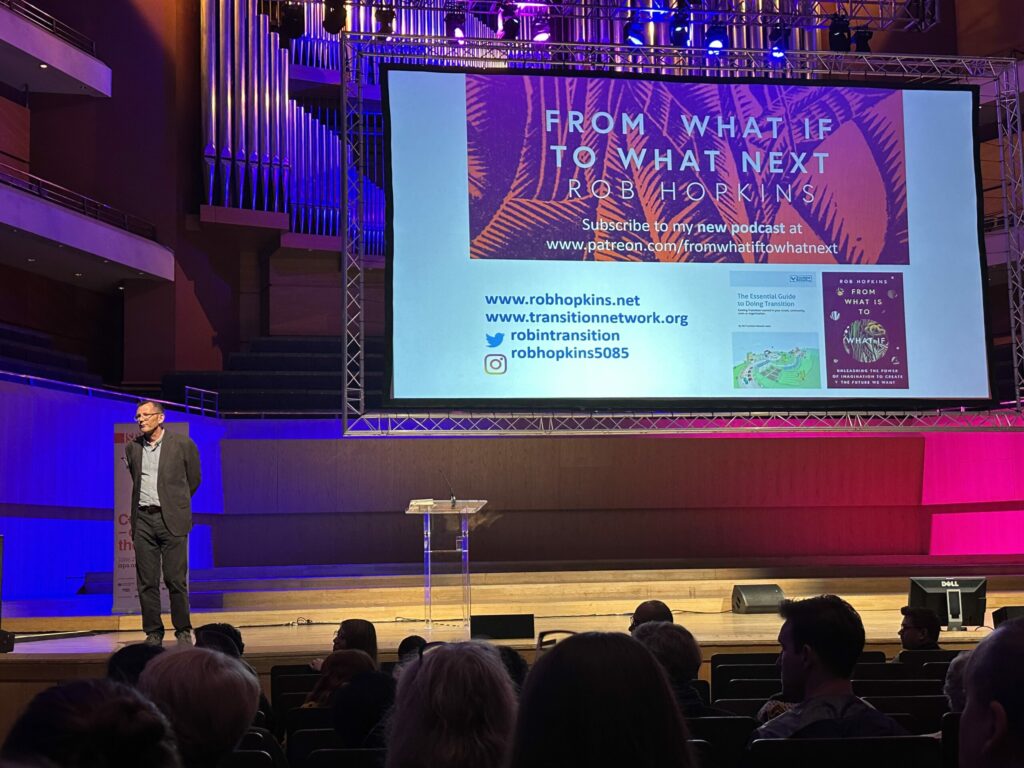
Heart of the Art Aravinth Kumaraswamy, Artistic Director of Apsaras Arts talks about his experience at the International Society for the Performing Arts (ISPA) that was held at Manchester, UK in June 2023. A report… This was the first time that I had the opportunity to attend the International Society for the Performing Arts (ISPA) session representing Apsaras Arts Dance Company. This year’s June 2023 edition was held in the historical city of Manchester in the UK, known for many things including music, football and its contribution to British history. The mission of ISPA is to strengthen the performing arts globally through the advancement of leadership, the exchange of ideas and by fostering a diverse and engaged membership. At the outset, looking at the well-thought through agenda, topics and sessions curated for ISPA Manchester June 2023, had this mission amplified. Co-creating the Future was the overarching theme for ISPA Manchester 2023. “What does co-creation really mean for performing arts leaders? How can co-creation help our sector move forward with intention, relevance and resilience? At the ISPA 2023 mid-year congress, we will come together in Manchester to take stock of where we are, to collectively reflect on these questions and to envisage what the journey forward could look like. Delegates will be challenged and inspired by a range of speakers and panelists, and we will provide space for conversation and exchange. Manchester has creativity and culture at its heart, and we look forward to welcoming delegates to explore the rich offering in the city and across the North West region.” The conference was structured into six key sessions with several other break-out sessions, performances and visits to iconic performing arts venues. The first session shed the spotlight on Co-creating the Future: Leadership and Co-creation. Over the years, there has been much discussion about balancing the power dynamic, but are we seeing any real change? The session deep-dived into who are the players who are setting the global cultural agenda and really whose voices are finding representation in the programming of the performing arts. The second session was titled Co-Creating the Future: Art and Next Generations. This session brought to fore the next generation of leaders and explored the opportunities and training options that are available to them. In line with the idea of co-creation, the session reinforced how co-creating can truly improve opportunities for the next generation. The next session focussed on the idea of equity, and was titled Co-Creating the Future: How do we co-create with equity? Focussing on the best practices in the industry, this session was a refresher in terms of how creators can ensure that all voices have equity in the space and what are some of the challenges and opportunities within. The fourth session was titled Co-creating the Future: The Role of the State in the Arts Sector. As a crucial session, this one was about how the state can actively collaborate with the arts and cultural sector without over-exerting its power; without interfering with thought and expression. The fifth session was titled Co-creating the Future: Sustainable Practice on the Road. This session was focussed on the notion of sustainability and allowed participants a sense of how they can learn from indigenous communities and other regions on how to reduce our carbon footprint. The final session was titled Co-creating the Future: Art and Conflict. There are many examples of arts projects that move to address these conflicts and/or raise awareness about those who are impacted. This session investigated in what ways these projects are effective, and do they, if at all, address the underlying sources of conflict. Each and every session was curated with thought and had enough room for questions and conversations. On the third day of the convention, ten new works were given an airtime to pitch for support and touring opportunities. Mehek, a contemporary dance production, produced by Aakash Odedra Company (UK) featuring Kathak dancers Akash Odera and Aditi Mangaldas caught my attention. Mehek is a new mainstage work by two of the great Kathak dancers of their respective generations: Aditi Mangaldas, dancing the first-ever duet of her 50-year Career with Aakash Odedra. Mehek gives a voice to an unspoken and overlooked love story – that of an older woman and younger man – weaving narrative that celebrates love in all its forms: raw, authentic, and infinitely resonant. In Mehek, the stage transforms into canvas, where bare feet inscribe rhythmic tales of desire, shadows blur and a single finger traces narrative down a trembling spine. These raw moments mirror the complexities of love, its electrifying spark, beguiling allure, shattering heartbreak and soothing comfort. Later that day, ISPA created an opportunity for art makers to share their works in an exhibition format of an Arts Mart. The Apsaras Arts Dance Company stall attracted many visitors which led to very interesting conversations. Overall, attending ISPA Manchester 2023 was a great meeting place to get to know art makers in the industry – from South America to Northern Asia – all under one roof.
Work-in-Process
Bharatanatyam artistes, Rama Vaidyanathan and Dr Apoorva Jayaraman, who are amongst the chosen artistes who will showcase their thematic new work under the umbrella of the theme, Ritu, curated by the Natyarangam festival at the Narada Gana Sabha in Chennai in August, decode their specific work and their take on its thought and treatment, in dance A Summer Surrender Dr Apoorva Jayaraman allows us insights into her treatment of Grishma When you received the theme Grishma from the Natyarangam Commitee, what was your initial response? I am born and raised in Bangalore, a city known for its great weather. Therefore, the one thing about living in Chennai that always irked me was the summer heat. It was the one thing I never managed to get used to, and I definitely did not enjoy. So, when I got to know that Grishma is the theme that Natyarangam was inviting me to work on, I thought to myself – “oh my gosh! “Irritation” is going to be my eternal sthayi bhava!!” For the first few days, the mind was a blank page. But now, being midway in the process, I appreciate being commissioned to work on a theme that I wouldn’t have naturally gravitated towards, as without an “obvious” starting point. I had to go on a journey to find what it meant to me, and what I wanted to say. Personally, what is your take or relationship with summer? How much of the personal do you bring to your work, in general? Fatigued. Irritable. Underproductive. These are the first few words that I would use to describe myself in the Indian summer. But when I thought beyond this tip-of-the-tongue response, I remembered the sweet feeling of taking a shower after a tough three-hour rehearsal or class in the sweltering heat, and lying on my bed, feeling the warmth spread through my exhausted muscles. A drenched dance saree, sweat splashing from my braid… this, I realised, is the real deal, the real visual I have of the Chennai summers. One is dead by the end of a practice, but you never wish you didn’t have to do it. Spring is a time of hope and dreams. The monsoons, almost a celebration. But summer is a time of toil, a conscious journey through harsh and unfriendly times to go nearer one’s goal.I began to see summer as a time where the human spirit demonstrates an extraordinary ability for perseverance, for survival and an inexplicable thirst to soar. This personal identification is definitely where I’m drawing from and what helps me want to tell a story, or even have a story to tell. The one liner for me is “Summer – the fire in my soul”. An artist’s job is to extrapolate the specific to the generic, in a manner that it finds resonance with a large number of people, without either losing (or over indulging in) its idiosyncrasies and frailties. So to answer your question, yes, the seed is personal. The impulse for the story, is personal. But the stories themselves are not necessarily so. Your concept note is an interesting exploration of a whole host of ideas that are connected with the notion of summer – romance, abundance, hope, fearlessness but also there is hardship and self-preservation; typically, what is your process of creating new work? Sometimes, the starting point of a work may simply be to explore something from an anthology of interest. I then read/explore/have conversations around the subject which slowly helps me understand the approach I want to take with the piece. Writing is the most important tool that helps me begin to articulate my ‘whys’ and to start to see a thread in my choices. Even though a first script may look either just like bare bones, or sometimes have too much clutter, the process of putting pen to paper strangely gives me the confidence to find my way. My biggest problem is knowing when to stop! In this regard, conversations with my teacher have always been my grounding factor – when I simply don’t know when to stop tweaking and fixing; or when I don’t know when to cross the threshold from research to visual stage, she has been my guide and compass. What is the kind of research that went into creating this particular work? In this particular instance, it started with reading a lot of literature to find references to summer. I read everything that came my way, shortlisting interesting portions from Kalidasa’s Rutusamharam, Kalithogai of Sangam Literature, Kavi Keshavdas’ Rasikapriya. For this particular project, Natyarangam greatly aided our process with strong starting points – talks and sharings from scholars like Dr Sudha Seshayyan. I came across a mention of some interesting songs on summer in an interview with artist Shubha Mudgal. Another of our resource persons Monali Bala helped me source and understand some of those which sounded intriguing. I had several rounds of conversations Dr Raghuraman, who each time draws me a further mile into the immensely fascinating nooks and corners of the world of Tamil literature, this time throwing at the me the exuberant verses of Kalingattuparani which embodies such potent imagination; and S Jayachandran, who always unsettles the equilibrium (in the best way) and impelled me to go beyond the “narratives” and find my eka-vakyata. In the world we live in, we don’t have the luxury of just shutting ourselves and focussing just on the work, right? How do you manage switching in and out of this process of being preoccupied with a work and also managing the everyday and the mundane? I visualise/dance in my head all the time. A lot of the creation of this work, in the sense of visualisation, has been happening outside the studio – in transit in an airport, in an auto getting from class to home, lying on bed waiting for sleep to hit etc. This time around I’ve also been doing some of the work on my students. This has been a fairly fresh
Anjana: Mother of Hanuman
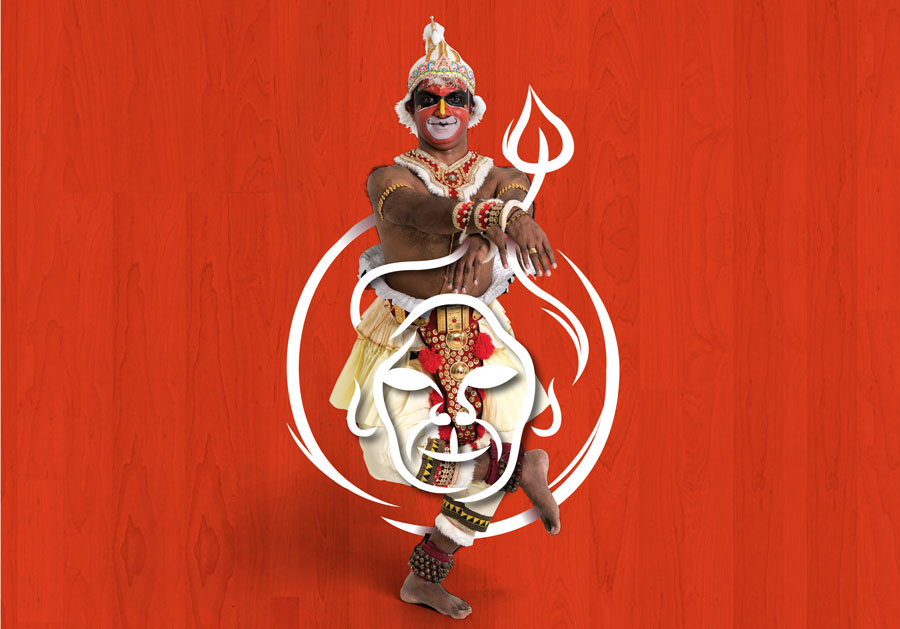
An insight from the concept of Anjaneyam: Hanuman’s Ramayana Hanuman was born to the humanoid creatures called the vanaras. His mother Anjana was an Apsara named Puñjikastalā, who was born on earth as a vanara princess due to a curse from sage Durvasa, and she married Kesari, a vanara chief. She was redeemed from this curse on her giving birth to a son. The Valmiki Ramayana states that his father Kesari was the son of Brihaspati and that Kesari also fought on Rama’s side in the war against Ravana. Anjana and Kesari performed intense prayers to Shiva to get a child. Pleased with their devotion, Shiva granted them the boon they sought. Hanuman, in another interpretation, is the incarnation or reflection of Shiva himself. Hanuman is often called the son of the deity Vayu; several different legends account for the Vayu’s role in Hanuman’s birth. One story mentioned in Eknath’s Bhavartha Ramayana (16th century CE) states that when Anjana was worshiping Shiva, the King Dasharatha of Ayodhya was also performing the ritual of Putrakama yagna in order to have children. As a result, he received some sacred pudding (payasam) to be shared by his three wives, leading to the births of Rama, Lakshmana, Bharata, and Shatrughna. King Dasaratha gave the pudding to Kausalya and Kaikeyi. However as Dasaratha was about to hand over the pudding to Queen Sumithra, a bird snatched the payasam and flew away from there. Both Kausalya and Kaikeyi immediately gave a portion of their own pudding to Queen Sumithra, because of which Queen Sumithra gave birth to twins – Lakshmana and Shatrugana. Queen Kausalya gave birth to Ram, the hero of Ramayana and Queen Kaikeyi gave birth to Bharat. The bird which stole the payasam also has a story. The bird was actually an Apsara – Suvarchala. Suvarchala was very impulsive and often acted without thinking. Once because of her impulsive behaviour, Lord Brahma got very angry with her and cursed her that she would become a bird. Suvarchala promised Lord Brahma that she had repented her ways. Lord Brahma said that his words could not be taken back and that Suvarchala would have to go to earth and stay as a bird. Lord Brahma however modified the curse and said that Suvarchala was to be freed from her curse if she touched the pudding given by Lord Agni to Dasaratha. Eager to have her curse lifted, Suvarchala snatched the pudding from Queen Sumitra. Immediately she changed form and became an apsara. The payasam fell from the bird’s claws and was falling to the ground when Vayu, the Wind God following the orders of Lord Shiva, blew the pudding softly without spilling it to the outstretched hands of Anjana, who consumed it. Hanuman was born to her as a result and was named “Anjaneyan, the son of Anjana. Birthplace of HanumanThere are multiple places in India are claimed as the birthplace of Hanuman 1) According to one theory, Hanuman was born on Anjaneya Hill, in Hampi, Karnataka.This is located near the Risyamukha mountain on the banks of the Pampa, where Monkey King Sugreeva and Lord Rama are said to have met in Ramayana Legend. 2) Anjan, a small village about 18 km away from Gumla, Bihar , houses ANJAN DHAM , which is said to be the birthplace of Lord Hanuman. The name of the village is derived from the name of the goddess Maa Anjani, the mother of Hanuman. Aanjani Cave, 4 km from the village, is believed to be the place where Mata Aanjani once lived. Many objects and items of archaeological importance obtained from this site are now held at the Patna Museum. 3) The Anjaneri (or Anjneri) mountain, located 8 km from Trimbakeshwar in the Nasik district, is also claimed as the birthplace of Hanuman. One has to trek around 6 kms up from the base of the trek to reach the birth place. 4) A cave in a hill near Gokarna, one of the oldest temple towns of India, is also said to be the birthplace of Hanuman. This cave has had a Hanuman temple for a long time. Gokarna, situated in west coast of Karnataka, is known for Atma Linga of Shiva, installed by Ganapathi to save it from the hands of Ravana long before Ramayana days.
Anjaneyam: Hanuman’s Ramayana
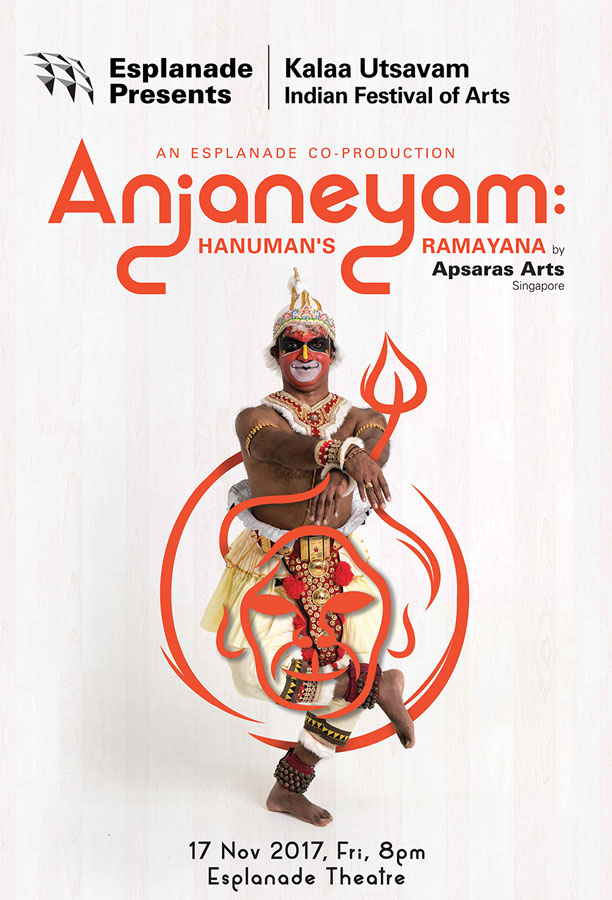
Synopsis For centuries, the ancient Indian epic The Ramayana has captured the imagination of Asia with its universal themes of righteousness, love, loyalty and frailty. One of the most beloved characters in the story is the monkey god Hanuman, who plays a crucial role in Prince Rama’s quest to rescue his wife, Sita, from the 10-headed demon king Ravana. Follow the life and adventures of Hanuman, from the time of his birth, to his meeting with the exiled Prince Rama, and to the heroic battle against Ravana and his forces. Watch the story unfold through dance and music, and bear witness to the birth of The Ramayanawhen Hanuman encounters its author Maharishi Valmiki. Conceptualised by Apsaras Arts, this cross-cultural production puts together a creative team from around Asia including Era Dance Theatre (Singapore), Kalakshetra Repertory Theatre (India) and Bimo Dance Theatre (Indonesia). It features an arresting juxtaposition of Indian and Southeast Asian depictions of the epic, told through bharatanatyam and Javanese dance and set to a stirring, original score. Creative Team Concept, Script and Artistic Direction: Aravinth Kumarasamy Research: Dr Sudha Sheshyan, Dr Pappuvenugopla Rao, Dr Charu Madhavan Music Composition: Dr Rajkumar Bharathi Music Co-Direction and Sound Design: Sai SharavanamChoreography: Mohanapriyan Thavarajah, Jayanthi Subramaniam, Hari Padman and Osman Abdul HamidDramaturge: Lim How Ngean Costume Design:Mohanapriyan Thavarajah Lighting Design & Projection Mapping Design Concept: Gyan Dev Singh Projection Mapping and Animation:Knownsense Studios Rehearsal Master: Renjith Babu Gallery Reviews Anjaneyam: Hanuman’s Ramayana brought to life once more. Cultural ties that bind India and South East Asia at PBD 2018 (Read more) – Connected to India, Garima Kapil “I laud the efforts of the whole team, in producing a show, given a limited time frame, without a dull moment, and with enough showmanship to keep the audience engaged for three hours – ” (Read more) – Narthaki, Lakshmi Vishvanathan “Carrying forward the narrative, flashback was used, and imaginative use of chorus, a la Greek theatre, reflecting what the main character is thinking. Such a large scale production deserves to be seen in other cities, where Ramayana is known to everyone and its performances are a living tradition” (Read more) – Narthaki, Padmashri Dr. Sunil Kotari “Apsaras Arts ‘Anjaneyam – Hanuman’s Ramayana’ staged at Singapore recently stood out for its cross-cultural appeal” (Read more) – The Hindu Padmashree, Dr.Sunil Kotari “It was heartwarming to see the impact of Anjaneyam on the excited crowd, their eyes completely locked on the action unfolding before them. Anjaneyam is completely deserving of the standing ovation it received at the end of the performance, a testament to the incredible talent we witnessed tonight from Singapore, India and Indonesia. This is precisely what a cross-cultural event at the Esplanade should feel like; a melting-pot of cultures and abilities coming together to produce an epic show that will live on deep in our hearts and minds, one we won’t be forgetting anytime soon.” (Read more) – Backchormeeboy “Mega dance-drama Anjaneyam — Hanuman’s Ramayana stood out with stunning visuals, exquisite dancing and excellent story-telling” (Read more) – Tabla Singapore, Padmashree Dr.Sunil Kotari Tour Performance Book the Show Anjaneyam is available for tours. Please contact apsaras.arts@gmail.com / kumarasamy.aravinth@gmail.com for more information
European Tour
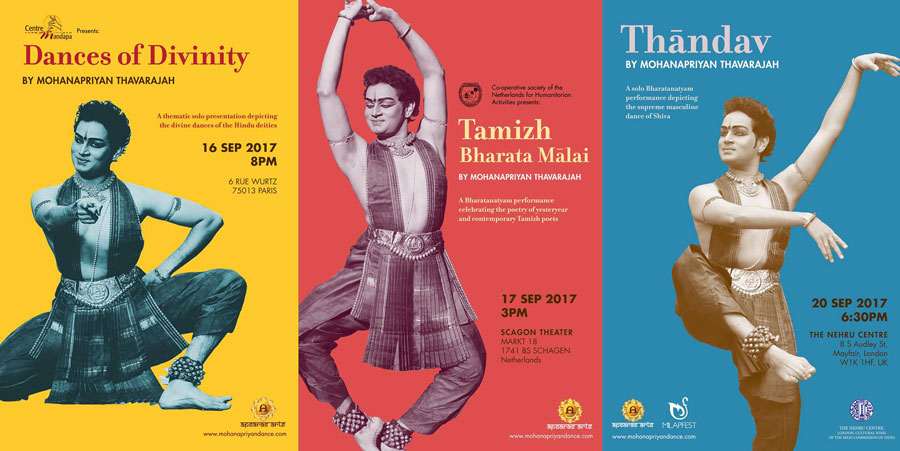
Mohanapriyan Thavarajah from Apsaras Arts will be on an European tour during September 2017 performing a collection of thematic solo Bharatanatyam performances, including “Dances of Divinity”, “Tamizh Bharatha Maalai” and “Tandav”. Mohanapriyan will be conducting a workshop for Milapfest on Saturday 22nd at Liverpool.Please find the following details of the shows and ticket details. Paris Centre Mandapa Saturday 16/09/17 at 8pm For tickets: www.weezevent.com/dances-of-divinity-mohanapriyan-tavarajah Netherlands Scagon Theatre Sunday 17/09/17 at 3pm For tickets: www.scagontheater.nl London Nehru Centre Wednesday 20/09/17 at 6.30pm For tickets: www.nehrucentre.org.uk/events/details/article/shiva-tandava-h3bharatanatyam-h3-h3mohanapriyan-thavarajahh3.html
Navarathri
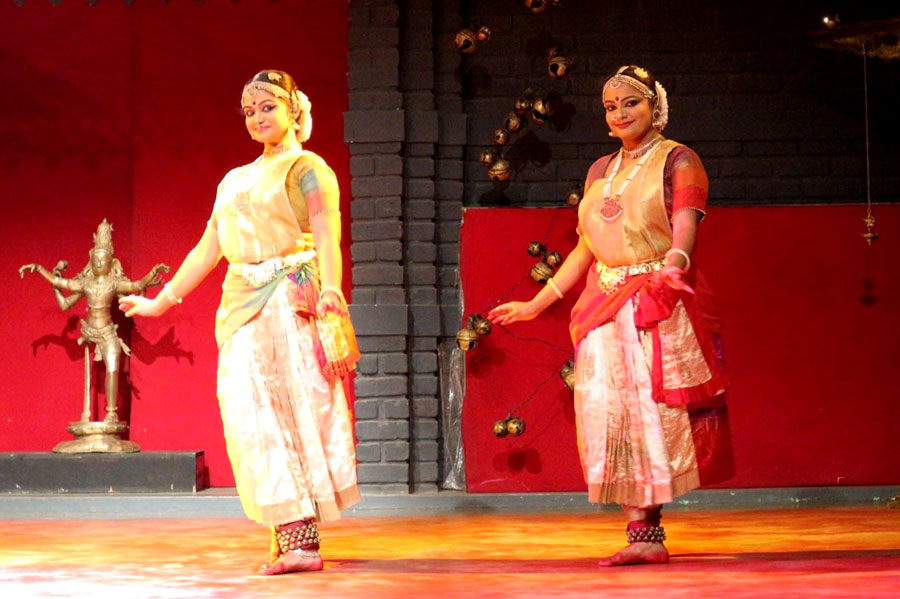
Following the tradition being followed in the past many decades, dancers from the Apsaras Arts Dance Company and dance students from Apsaras Arts Academy will be performing for the annual Navarathri celebrations across Singapore. Please see details below Sri Vadapathira Kaliamman Temple 555 Serangoon Rd, Singapore 218174 on Friday 22nd September, 2017, 8:50 pm Sri Mariamman Temple 244 South Bridge Rd, Singapore 058793 on Sunday 24th September, 2017, 8:50pm Sri Thendayuthapani Temple 15 Tank Rd, Singapore 238065 on Wednesday 27th September 2017, 9:00pm Sri Senpaga Vinayagar Temple 19 Ceylon Rd, Singapore 429613 on Friday 29th September 2017, 7:30pm
Vijayadasami
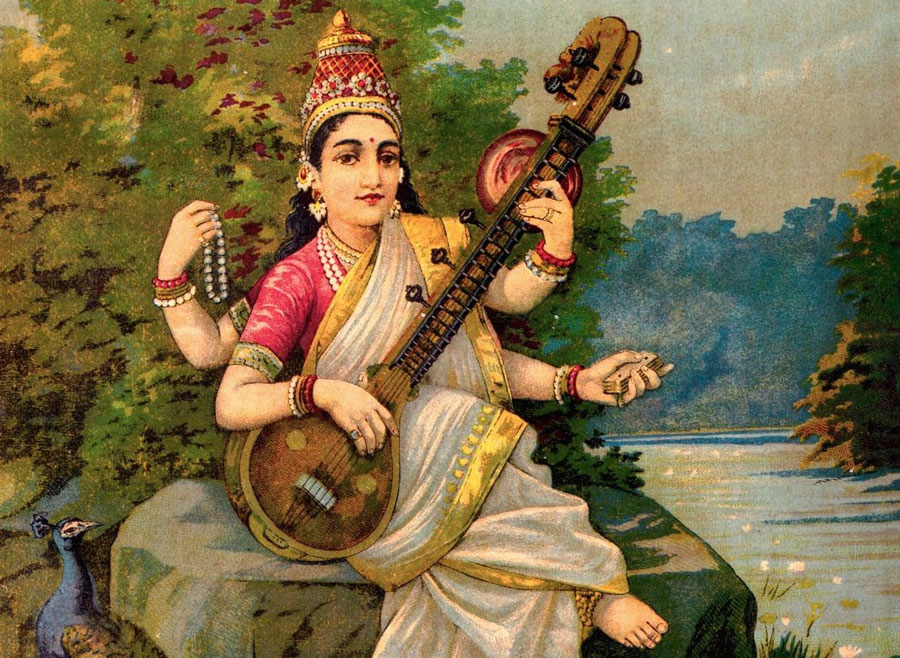
On Vijayadasami day which falls on the tenth day of Navarathri, it is a tradition to pay respects to your Gurus and to partake in the Vidhyarambam observation where very young children and anyone who wants to pick up a new art from are initiated in to the learning. Please find the following details on the Vijayadasami celebrations at Apsaras Arts. Saturday 30th September 2017, at Apsaras Arts studios, Block D #01-24, Goodman Arts Centre, 90 Goodman Road, Singapore 439053 7:30am to 9:00am: Homam and Pooja 10:00am to 12:00pm :Initiation to new classes
Apsaras Arts at UTSAV
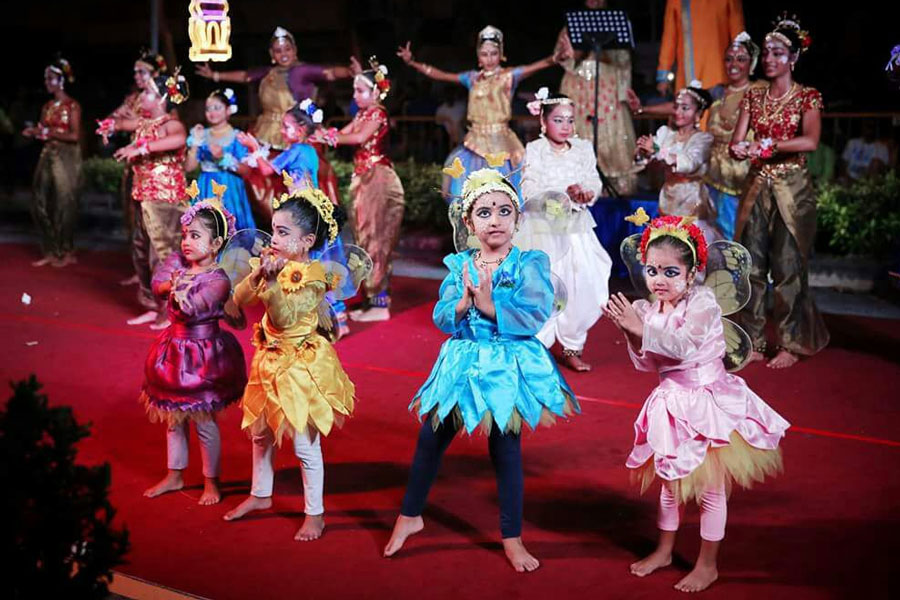
Apsaras Arts Academy students at UTSAV 2017 Street Parade, heralding in the Deepavali festivities with cultural performances by local and international artistes. The performance by Apsaras Arts Academy students was themed as “Apsaras in the Gardens” and featured Kathak and Bharatanatyam genres of Indian classical dance. Dance students as young as 4 years were part of the 45 member strong team from Apsaras Arts Academy.